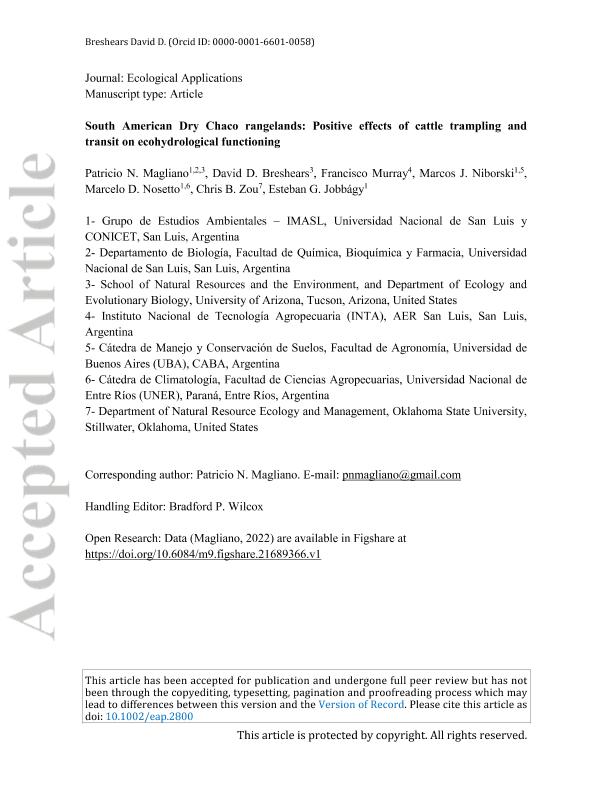Artículo
South American Dry Chaco rangelands: Positive effects of cattle trampling and transit on ecohydrological functioning
Magliano, Patricio Nicolás ; Breshears, David D.; Murray, Francisco; Niborski, Marcos Javier
; Breshears, David D.; Murray, Francisco; Niborski, Marcos Javier ; Nosetto, Marcelo Daniel
; Nosetto, Marcelo Daniel ; Zou, Chris B.; Jobbágy, Esteban G.
; Zou, Chris B.; Jobbágy, Esteban G.
 ; Breshears, David D.; Murray, Francisco; Niborski, Marcos Javier
; Breshears, David D.; Murray, Francisco; Niborski, Marcos Javier ; Nosetto, Marcelo Daniel
; Nosetto, Marcelo Daniel ; Zou, Chris B.; Jobbágy, Esteban G.
; Zou, Chris B.; Jobbágy, Esteban G.
Fecha de publicación:
04/2023
Editorial:
Ecological Society of America
Revista:
Ecological Applications
ISSN:
1051-0761
Idioma:
Inglés
Tipo de recurso:
Artículo publicado
Clasificación temática:
Resumen
Livestock production in drylands requires consideration of the ecological applications of ecohydrological redistribution of water. Intensive cattle trampling and the associated increase of surface runoff are common concerns for rangeland productivity and sustainability. Here, we highlight a regional livestock production system in which cattle trails and trampling surrounding an artificial impoundment are purposely managed to enhance redistribution and availability of water for cattle drinking. Based on literature synthesis and field measurements, we first describe cattle production systems and surface water redistribution in the Dry Chaco rangelands of South America, and then develop a conceptual framework to synthesize the ecohydrological impacts of livestock production on these ecosystems. Critical to this framework is the pioshere—a degraded overgrazed and overtrampled area where vegetation has difficulties growing, usually close to the water points. The Dry Chaco rangelands have three key distinctive characteristics associated with the flat sedimentary environment lacking fresh groundwater and the very extensive ranching conditions: (1) cattle drinking water is provided by artificial impoundments filled by runoff, (2) heavy trampling around the impoundment and its adjacent areas generates a piosphere that favors runoff toward the impoundment, and (3) the impoundment, piosphere, and extensive forage areas are hydrologically connected with a network of cattle trails. We propose an ecohydrological framework where cattle transit and trampling alter the natural water circulation of these ecosystems, affecting small fractions of the landscape through increased runoff (compaction in piosphere and trails), surface connectivity (convergence of trails to piosphere to impoundment), and ponding (compaction of the impoundment floor) that operate together making water harvesting and storage possible. These effects have likely generated a positive water feedback on the expansion of livestock in the region with a relatively low impact on forage production. We highlight the role of livestock transit as a geomorphological agent capable of reshaping the hydrology of flat sedimentary rangelands in ways that can be managed positively for sustainable ranching systems. We suggest that the Dry Chaco offers an alternative paradigm for rangelands in which cattle trampling may contribute to sustainable seminatural production systems with implications for other dry and flat rangelands of the world.
Archivos asociados
Licencia
Identificadores
Colecciones
Articulos(IMASL)
Articulos de INST. DE MATEMATICA APLICADA DE SAN LUIS
Articulos de INST. DE MATEMATICA APLICADA DE SAN LUIS
Citación
Magliano, Patricio Nicolás; Breshears, David D.; Murray, Francisco; Niborski, Marcos Javier; Nosetto, Marcelo Daniel; et al.; South American Dry Chaco rangelands: Positive effects of cattle trampling and transit on ecohydrological functioning; Ecological Society of America; Ecological Applications; 33; 3; 4-2023; 1-19
Compartir
Altmétricas



